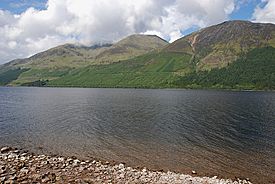Battle of the Shirts facts for kids
Quick facts for kids Battle of the Shirts(Blàr na Léine, Kinloch-Lochy) |
|||||||
|---|---|---|---|---|---|---|---|
| Part of the Scottish clan wars | |||||||
 Loch Lochy |
|||||||
|
|||||||
| Belligerents | |||||||
| Clan Fraser of Lovat Assisted by Clan Grant and Clan Mackintosh |
Clan Macdonald of Clanranald Assisted by Clan Cameron |
||||||
| Commanders and leaders | |||||||
| Hugh Fraser, 3rd Lord Lovat | John of Moidart (Iain Muideartach) | ||||||
| Strength | |||||||
| 300 | 500 | ||||||
| Casualties and losses | |||||||
| 5 survivors (295 killed) |
8 survivors (492 killed) |
||||||
| Official name | Blar na Léine | ||||||
| Designated | 14 December 2012 | ||||||
| Reference no. | BTL29 | ||||||
The Battle of the Shirts (also known as Blàr na Léine or the Battle of Kinloch-Lochy) was a big fight between different Scottish clans. It happened in July 1544 in a place called the Great Glen, near the top of Loch Lochy.
On one side were the Clan Macdonald of Clanranald and their friends, the Clan Cameron. On the other side were the Clan Fraser and people from Clan Grant. This important battlefield is now protected by Historic Scotland.
The battle got its name because people say it was a very hot day. Both sides supposedly took off their heavy metal armor, called chainmail, and fought only in their shirts. But some people today think the name Blàr na Léine might actually mean 'the Field of the Swampy Meadow'. This is because the ground there was quite wet and marshy.
Why the Battle Happened
The main reason for the battle was a disagreement over who should be the leader, or chief, of the Clan Macdonald of Clanranald. There were two people who wanted to be chief.
Hugh Fraser, 3rd Lord Lovat, who was the leader of the Clan Fraser of Lovat, supported one of these people, named Ranald Galda. Lord Lovat gathered about 400 of his best fighters. They joined forces with the Earl of Huntly, who was a powerful leader in the north of Scotland.
Their plan was to defeat the MacDonalds and make Ranald the new chief. The combined Fraser and Gordon forces marched to Inverlochy. They successfully took over Castle Tioram, which helped Ranald gain control of the Moidart area.
The Battle Begins
After their success, the Earl of Huntly decided to take his soldiers and go back to his own lands. Lord Lovat and his Fraser men then headed up the Great Glen towards Glenmoriston. It seems Lovat and Huntly thought the MacDonalds were no longer a threat after they split up.
However, the MacDonalds had been secretly following the invaders. They had waited because they had fewer fighters. But once Huntly's men left, the MacDonalds quickly moved to surround Lord Lovat's group. They surprised the Frasers in a wild, marshy area north of Loch Lochy.
As mentioned, this battle became known as Blar-ne-leine, or "the field of the shirts." This was because the day was so hot that the Highland warriors took off their heavy armor and fought in their shirts. (Though some modern experts believe it refers to the marshy ground).
Lord Lovat and his Frasers were outnumbered. He could have tried to escape, but instead, he bravely led his men into a full battle. Sadly, Lord Lovat and his son, who was next in line to be chief, were both killed. Hundreds of their men also died. The MacDonalds won the battle.
What Happened After
Lord Lovat and his son were later buried at Beauly Priory. After this, the Earl of Huntly mostly focused on other parts of Scotland. This meant that John MacDonald, along with the chiefs of Clan Cameron, Glengarry, Keppoch, and Glencoe, were free to take things from the areas near Urquhart Castle in April 1545. They destroyed what they didn't take.
The Scottish Parliament tried many times to make John answer for his actions, starting in September. But John never showed up. There are no records that Parliament ever managed to make the leader of Clanranald explain himself. John finally passed away in 1584, still not having apologized for his actions.

